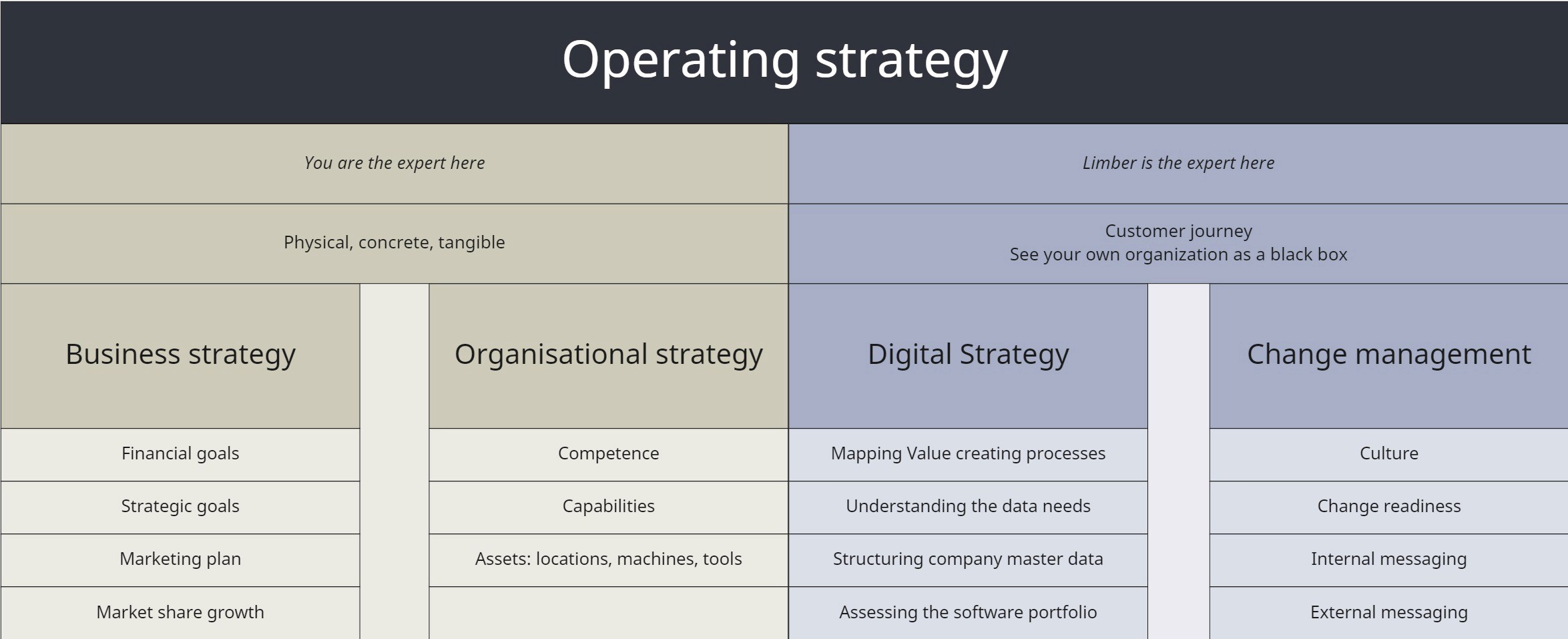The flavors of digital strategy
Oct 21, 2024

In this series of articles, we share our insight into the key components required for a holistic approach to strategic development. While most organizations are adept at establishing a business strategy (financial goals /operational KPIs etc), they often stop short of developing the underlying systems needed to reach those goals. The tools and actions for achieving business goals are typically developed at the operational level. They are typically found as elements in the respective areas of the Digital Strategy (SW portfolio, data management), Organizational strategy (Competence, assets), and Change management (Culture, change readiness, internal and external messaging).
Introduction
In this series of whitepapers/articles we will walk you through the various flavours of strategy, how they impact your business and the key components of a winning operating strategy.

The business strategy
The four pillars shown in the figure above, business strategy is the first of these. The business strategy sets the direction for the company, in other words “what we want”. The other three (and corresponding action plans) answer “how to get there”.
The organizational strategy
Operational strategy involves development of people, competence, and organization structure as well as physical assets (property, tools). Most companies are skillful at this as well, being an integral part of one or more business domains. The experience and tools to perform in any industry develops and matures over the years.
And just when everything was under control, the market, technology or new entrants changes everything.
The digital strategy
Digital opportunities today are emerging faster than most traditional businesses can cope with. The previous limitations on integrations and hardware are falling away. The result is a vast (and daunting) space of opportunities. The potential to fail is very real. The need for digital development has driven the cost of performing such work up, and made talent difficult to attract. It requires a new type of competence to evaluate and lead digitalization, and one that was not until recently required to run a successful small to medium sized engineering or industrial business.
The third pillar of our holistic strategy is therefore: A digital strategy. In its essence, the digital strategy involves building data support for existing value creating processes. This unlocks new levels of productivity by adding transparency, live status and computing power to complex interactions (i.e a production line, or a multi discipline project). It can automate repetitive tasks, improve situation overview, and free up administrative personnel to address problem solving (now) to planning (ahead). Developing a successful digital support platform for current business model involves:
Mapping current value creating processes (and digital support for these)
Understanding the various user data needs (operations, project, management)
Structuring company master data (based on previous step)
Software portfolio (evaluate current software landscape fit (cost/benefit), data gaps and potential changes, new entrants and future direction)
Establish change actions, execute and evaluate (Plan-do-check-act)
Continuously assessing and repeating the above steps more efficiently than competitors
While boosting the current business model, the digital platform therefore also becomes an important factor in realizing both incremental and radical future business models (as defined in the Business Strategy).
A note from the authors: the above approach is focused on digital operations support (processes, resources, planning and logistics - the doer tasks). There are of course also major digital advancements in marketing, hardware (technology) and network based technologies. Our focus here is on your processes, projects and software - setting up for new levels for effectiveness and productivity.
A successful digital strategy (and being able to communicate it) is critical to attracting and retaining talent. Making an effort at removing repetitive tasks and freeing up time for planning ahead, increases motivation and creative thinking. The digital journey improves the attractiveness of both the company and those who work there.
Change management strategy
It’s really all about people – while the development of digital tools, marketing plans and strategic actions are important, people and their competence are really the primary asset of any company. Change management is all about motivating people, seeing the need to change, developing a vision and executing on it. This is leadership in a nutshell. Change management is also about increasing change readiness, developing an organizational culture that is responsive to change over time. This is not an easy feat, especially in well-established organizations. It involves a fresh outlook on internal messaging, incentives, core values and organizational structure. Change readiness is not about age, it’s about mindset.
Operating strategy – the sum of all parts
We have now briefly touched on what we have labelled as the four flavors of strategy. We want to introduce the term Operating Strategy – as the overarching ability to coordinate and develop these 4 pillars in unison. This is fundamental to create value and build your company into a stable and effective business in an increasingly volatile business environment. It sets you up to utilize technological opportunities and develop a competitive edge and strengthen market position and uniqueness.
In the following article series, we will delve deeper into each strategic area/pillar. We apologize in advance that our attention might be skewed towards digital strategy and change management. These are, after all, our core areas of interest.
And where we hope to be a valuable partner to our clients for years to come. We hope you will ride along. Sincerely, the Limber team.
If you liked this article, check out our next one in the series: Change management - Setting up for success
